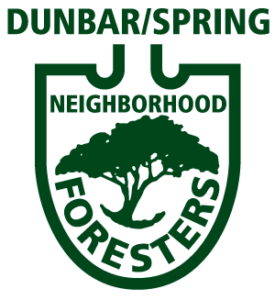While flyers, and notices in neighborhood newsletters and list serves or message boards, help get the word out about an upcoming planting or other foresters event, face-to-face conversations are far more effective.
Face-to-face is best
Greet passerbys as you are working in the neighborhood. Introduce yourself when you see neighbors you don’t know, and briefly share the forestry work you are doing that day. Could be as brief as, “We’re out here working with neighbors to plant food-bearing shade trees irrigated for free with water we’ll capture from the street.” If they express interest, share a little more, or invite them to join. If they are into that, get their name and contact info so you can contact them directly for the next event. If using gmail, you can create a group email list in Contacts for the folks interested in forestry events in your neighborhood. Though one-on-one contact will be even more effective, like texting or calling folks when you’ll be doing work on their block.
Volunteers from the Dunbar/Spring Neighborhood Foresters go to neighborhood meetings, knock on doors, and introduce ourselves and the program preceeding events (and if for a planting we bring maintenance/stewarding agreements and tree order forms)—focusing on the areas that really need the work, such as areas of the public right-of-way devoid of trees. This way we get to know more of our neighbors (and they get to know us), we can answer their questions, and we can show them before and after pictures of our work.
It does not matter if people we meet don’t want to participate when we first engage them. The point is to start a relationship, to invite them to participate if and when they are ready. Sometimes this takes months, sometimes years. And when they do participate it may not be with physical help, like planting; it may be in the form of a donation, permission to clear away a barrier to a public path in front of their place, their coming to trainings, sharing what they’ve learned with others, etc.). The point is, every interaction is an opportunity to educate neighbors about what we are doing, and to learn of their concerns and needs—which can help inform and evolve our actions. Such feedback contributed to the Dunbar/Spring Neighborhood Foresters expanding and evolving its programing to have much more help and training in plant care and stewarding, as that became a bigger concern after years of successful community plantings, but there was a shortfall in individual- and community-initiated maintenance and stewardship.
Flyers and more
Flyers, emails, and newsletter announcements also help. Best if they can link to a webpage with more detailed info for the interested.
Flyers are especially good to post in areas of the neighborhood where you do not yet have any direct relationships with the neighbors there, but are trying to make those contacts. Especially if those neighbors are unlikely to check out a website or social media post. At minimum, you can leave a flyer with a neighbor; or post one where they will likely see it, perhaps at a community center or house of worship, or on a utility pole or mail box cluster beside the pedestrian path they walk.
The flyer below is for a Neighborhood Rain, Tree, & Understory Planting that utilizes contractors to excavate and build the water harvesting basins before volunteer crews follow to plant. Feel free to use and adapt the flyer text if useful for you.
And if you want to go further still, make and wear Neighborhood Forester t-shirts to further identify who you are and that you are part of something bigger open to all.
